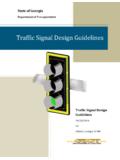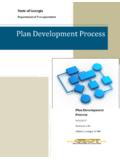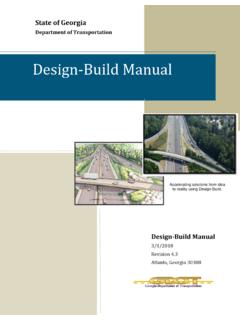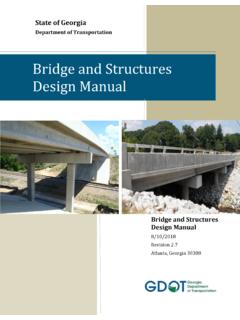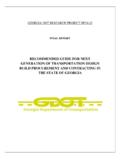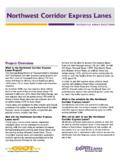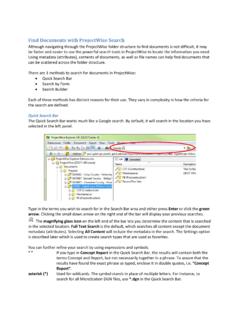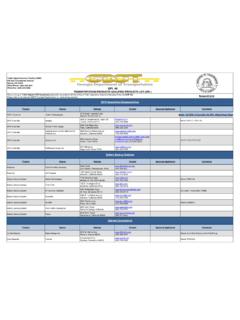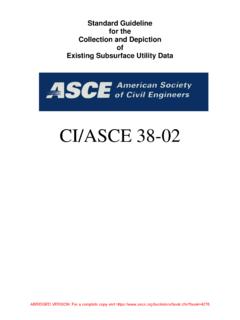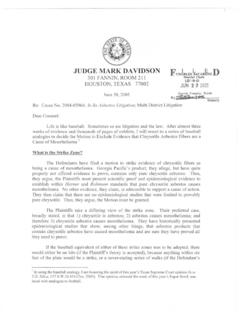Transcription of DEVELOPING STRATEGIC SYSTEMS SUPPORTING …
1 GDOT Research Project No. 10 05 Task Order No. 02 70 Final Report DEVELOPING STRATEGIC SYSTEMS SUPPORTING communities OF PRACTICE IN THE georgia department OF transportation By Gordon Kingsley, Associate Professor School of Public Policy, georgia Institute of Technology Janelle Knox Hayes, Assistant Professor School of Public Policy, georgia Institute of Technology Juan Rogers, Associate Professor School of Public Policy, georgia Institute of Technology Prepared for Office of Materials and Research georgia department of transportation December 2011 The contents of this report reflect the views of the author(s) who is (are) responsible for the facts and the accuracy of the data presented herein. The contents do not necessarily reflect the official views or policies of the georgia department of transportation or of the Federal Highway Administration.
2 This report does not constitute a standard, specification, or regulation. Acknowledgements The authors of this research gratefully acknowledge the sponsorship and support of the Office of Materials and Research of the georgia department of transportation . This work is prepared as part of GDOT Research Project Number 10 05. We would also like to acknowledge the thoughtful guidance and assistance provided by managers within the georgia department of transportation . We benefited greatly from the work of an advisory board for this project. The members included Terry Brigman, Marlo Clowers, Gail D'Avino, Cindy VanDyke, Johnny Quarles, Darryl Richardson, Brad Saxon, Tim Matthews, Marc Mastronardi, Mike Perdue, Eric Pitts, and Scott Zehngraff. We are also benefited from the insights and guidance of Mr. Rick Smith, Deputy Director of Human Resources, Training and Development for GDOT, who provided the vision for this project and provided counsel and guidance to the research team.
3 The contents, findings, and recommendations from this report represent the views of the authors of this report. They do not represent the views of the georgia department of transportation or the managers with whom we worked closely during the course of this research. Any errors or omissions are the sole responsibility of the research team. i Abstract This study is designed to explore strategies through which the georgia department of transportation (GDOT) can develop communities of practice to help employees facilitate critical exchanges of knowledge, support organizational learning, and ultimately achieve improvements in performance outcomes. communities of practice (CoP) are groups of professionals working on behalf of an organization who develop on going informal knowledge exchanges as a means of learning about and performing key job related processes and skills.
4 The study consisted of four main objectives: 1) to map the incidence of CoP in GDOT, 2) to monitor patterns of knowledge flows through CoP, 3) to assess the costs and benefits of CoP, and 4) to develop a strategy for application of SharePoint to the development of CoP. The study was conducted using multi method research including interviews across key agencies, a communications log and workshops with GDOT professionals. A number of existing types of CoP were identified. Through a communications log, knowledge exchanges were mapped and communication patterns were established according to a typology of five CoP characteristics. Six groups of communication patterns were identified with varying degrees of CoP intensity (weak or strong CoP communications). Weak CoP communications are associated with knowledge search costs, while strong CoP communications are associated with knowledge validation and application costs.
5 It is recommended that GDOT tailor its strategy of enhancing communication within the organization by addressing the different needs of weak and strong CoP communications. To reduce knowledge search costs, it is recommended that GDOT conduct a knowledge needs assessment and centralize and enhance expertise information into a common directory. SharePoint utilities may assist with various aspects of this functionality. To reduce the costs associated with validating and applying knowledge, it is recommended that GDOT pursue a strategy of systemically building CoP through a combination of social networking, face to face training, on line documentation of official policy statements and standards, and the dissemination of information and training sessions as changes occur in standards. Keywords: communities of Practice, Knowledge Management, Retention, Strategy ii Table of Contents Acknowledgements.
6 I Abstract .. ii Table of Contents .. iii List of Tables .. v List of Figures .. vi Introduction .. 1 Lessons from the Research Literature on communities of Practice .. 7 Task 1: Mapping the Incidence and Nature of CoP in GDOT .. 13 Interviews 14 Analysis of the Communication Logs .. 19 Knowledge Exchanges .. 20 Analyzing Communication patterns associated with communities of Practice .. 24 Evaluating the CoP metrics with factor analysis .. 26 Evaluating the CoP metrics across all five categories .. 31 Task 2: Monitoring Patterns of Communication and Knowledge Exchanges and CoP in GDOT .. 37 Task 3: Assessing Costs and Benefits of CoP .. 49 The Development of the Geographic Information SYSTEMS CoP .. 53 The Development of a Practical Design Training CoP .. 56 Task 4: DEVELOPING a Strategy for the Application of SharePoint to Support CoP.
7 59 iii Conclusion .. 66 Appendix: Research Protocols .. 72 References .. 86 iv List of Tables Table 1: Attributes of communities of Practice .. 9 Table 2. communities of practice within GDOT .. 15 Table 3. Features of GDOT's communities of practice .. 17 Table 4. COP Identified in Interview and in the communication log surveys: .. 20 Table 5. Knowledge Exchanges over the course of the week .. 21 Table 6. Percentage of Respondents who initiated the knowledge exchange .. 21 Table 7. Percentage of respondents who exchanged knowledge with someone who shared responsibility for a task .. 22 Table 8: Percentage of knowledge exchanges that required expertise outside of the team .. 23 Table 9. Percentage of respondents that could not complete a task without the knowledge that was exchanged .. 23 Table 10. CoP Attributes identified as characterizing respondent knowledge exchanges.
8 25 Table 11. Use of Various Knowledge Sources .. 42 Table 12. Knowledge Exchange Purposes .. 43 Table 13. Types of Knowledge Exchanged .. 44 Table 14. Importance of Knowledge Exchanges .. 45 Table 15. Modes of Communication .. 47 Table 16. Summary of Benefits and Costs .. 58 v List of Figures Figure 1. Typology of GDOT's communities of practice .. 18 Figure 2. Four Groupings of Communications According to Informality, Awareness of Practice, and Organizational Reach .. 27 Figure 3. Percentage of knowledge exchanges across four knowledge exchange types .. 28 Figure 4. Summary of communications under each grouping of communication type .. 29 Figure 5. Six Groupings of Knowledge Exchange According to Informality, Awareness of Practice, Organizational Reach, Practice Motivation and Frequency.. 32 Figure 6. Percentage of knowledge exchanges across six groupings of exchange type.
9 33 Figure 7. Summary of respondent description of knowledge exchanges under six groupings .. 34 Figure 8. Days with Exchanges as a Function of Age .. 41 Figure 9. Frequency of Use of Sources .. 42 Figure 10. Frequency of Knowledge Exchange Purposes .. 43 Figure 11. Frequencies of information type consulted .. 44 Figure 12. Frequencies of the importance of the knowledge exchanged .. 46 Figure 13. Frequency of modes of communication .. 47 vi Introduction This research is designed to explore strategies through which the georgia department of transportation (GDOT) can develop communities of practice to help employees facilitate critical exchanges of knowledge, support organizational learning, and ultimately achieve improvements in performance outcomes. We define communities of practice (CoP) as groups of professionals working on behalf of an organization who develop on going informal knowledge exchanges as a means of learning about and performing key job related processes and skills.
10 Those public agencies that have embraced the idea of CoP tend to do so as part of a larger knowledge management agenda of transforming traditional bureaucratic organizations into learning organizations and DEVELOPING strategies for knowledge retention and management (Snyder, Wenger, and Briggs, 2004). Public agencies have experienced a growth in interest in SUPPORTING CoP (Snyder, Wenger, and Briggs, 2004). Several factors contribute to the urgency felt in human resources offices to develop effective knowledge management and learning strategies (Luen and Al . Hawamdeh, 2001; Desouza, 2009). Chief amongst these is the graying of the public sector work force (Elliott, 1995; DeLong, 2004). To address this issue, public agencies have struggled with the development of effective strategies for transferring knowledge across generations.
